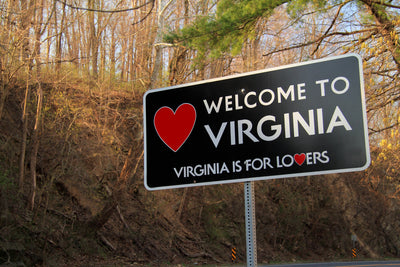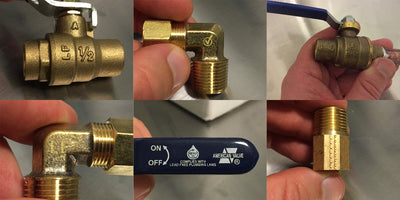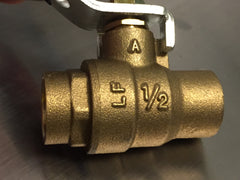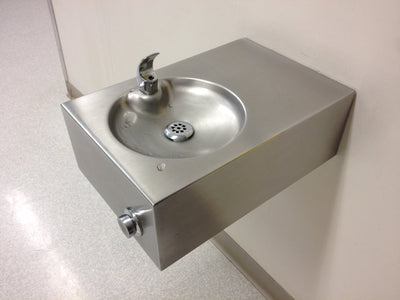Water Quality InformationWritten By Actual Experts
RSSProblems We Found in Fairfax County, Virginia’s Drinking Water

Does Your Home Have Lead Plumbing? Here's How To Tell

Eric Roy, Ph.D. | Scientific Founder
We get a lot of questions about lead service lines and how to tell if you have lead pipes, and we thought that it would be worth putting together an article that talks about some of the lesser known places where lead can exist in residential plumbing. Most people are surprised to learn that up until 2014, EPA allowed lead exist in fixtures & valves used for drinking water lines!
The Evolution of “Lead Free” Plumbing
When the Safe Drinking Water Act (SDWA) was amended in 1986, it mandated that residential plumbing could not use any pipe, pipe fitting, solder, flux, or fixture that was not “lead free.” While the term “lead free” seems pretty straightforward, the law allowed for the definition of "lead free" to evolve. The chart below shows allowable lead levels in solder, pipes, fittings, and fixtures through the 25+ years that lead was phased out of plumbing. It's worth pointing out that, it wasn’t until very recently (2014) that all pipes/fittings/fixtures used for drinkable water were required to contain negligible amounts of lead.
Maximum Levels of Lead Allowed in Residential Plumbing
| Years | Solder/Flux | Pipes, Fittings, Valves |
| Before 1986 | 50% | 100% |
| 1986-2014 | 0.2% | 8% |
| After 2014 | 0.2% | 0.25% |
How to Determine If Plumbing in Your Home Is Lead Free
Solder: Unfortunately, there is no easy way to visually tell how much lead is in soldered joints after the connection is made. If you are getting plumbing work done, it's ok to ask your plumber to see the package for the solder that they are using. It should prominently say “lead free” on it.






What To Do If Your Home Has Lead Plumbing
As the US has become increasingly aware of lead contamination in drinking water because of the ongoing crisis in Flint, recent violations in large cities like Pittsburgh, and longstanding lead problems in old cities like Chicago and New York City, more and more people are asking what they can do to minimize their family's exposure to lead.
The best way, bar none is to:
- Use a high quality filter at each faucet used for drinking. Any filter should meet or exceed NSF Standard 53 for lead filtration performance.
If you are unable to use a rated filter, or if the filter you use does not protect against lead (like most pitchers and fridge filters), you can take the following steps to minimize exposure:
- Allow your faucet to run for at least 2 minutes before collecting water for consumption (drinking/cooking/washing food). Doing so allows the water sitting in the pipes to flush out and be replaced by fresh water flowing through the large mains.
- Only use the faucet at a slow flow rate when collecting water for consumption. Doing so minimizes the amount of lead particulates that can be swept into the stream and carried to the faucet.
As always, we encourage everyone to take advantage of Hydroviv's "Help No Matter What" technical support policy, where we answer questions related to drinking water and water filtration, even if you have no desire to purchase our products. Drop us a line about lead pipes in homes at support@hydroviv.com, or use our live chat function.
Related Articles:
Does New York City Tap Water Expose More People To Lead Than Flint?
Pittsburgh's Lead Level Exceeds EPA Limits In 2016
Why You Are Being Mislead By Your TDS Meter
Why Do So Many Schools Have Lead in the Drinking Water?

Eric Roy, Ph.D. | Scientific Founder
With schools in major cities across the country testing positive for lead contamination (e.g. New York City, Cleveland, Chicago, Portland, Newark, San Francisco), we get lots of questions about what’s happening. The goal of this article is to shed some light on why lead in school drinking water is such an important thing.
There is no level of lead that is known to be safe for children. Period.
Since lead contamination in tap water entered the spotlight in 2015, people have incorrectly presented EPA's regulatory limits as safe/not safe thresholds. While a simple safe/unsafe threshold would certainly make things more simple, the 15 ppb threshold was never intended to be a "safe level." It’s a limit that EPA established to evaluate city-wide corrosion control practices and it allows a city to have up to 10% of samples test ABOVE the 15 ppb threshold, and still be in compliance with the Lead and Copper Rule. For reference, the American Academy of Pediatrics is calling for regulatory changes that ensure that water never tests above 1 ppb in schools.
Most Schools Are Old & Old Plumbing Often Contains Lead
According to data assembled by the U.S. Department of Education, the average age of a Public School building in the United States is 44 years old, a time when lead-based plumbing was the norm. Even in newer schools, lead contamination can creep into water because lead wasn’t completely phased out of plumbing connections, fittings, and valves until 2014.
Weekends & Summers Allow Water To Sit Stagnant For Extended Periods Of Time In Schools
As many now realize, lead accumulates in water when it leaches from lead-containing pipes, valves, and plumbing connections. The longer water sits stagnant in pipes, the more lead it can accumulate. Unlike in homes, where water is used on a daily basis and never sits stagnant for more than a few hours each night, water in schools goes completely unused for long periods of time each weekend, vacation, and summer. These frequent long periods where water is not used are detrimental for two reasons:
- Lead has more time to accumulate as water sits stagnant in lead-containing pipes
- The lack of flushing prevents corrosion measures from rebuilding the protective layer that prevents lead from leaching out in the first place.
Most Schools Do Not Test Water Properly For Lead Contamination
It sounds crazy, but most schools don’t test for lead contamination in water. When asked by a reporter about testing the school’s water for lead, an elementary school superintendent went on record to say that "We do not test because it has never been brought up as a concern, nor is it a requirement to do so."
The reality is, even if schools choose to test for lead contamination, it’s much more complicated than testing in a residential home. In a residential home, EPA sampling protocols require that water be unused for 6 hours, in order to simulate the night and work day periods where water commonly sits stagnant in pipes. However, this protocol does not mimic how water is used in schools, because in addition to the 12 hours each school night the water goes unused, it sits stagnant for roughly 60 hours each weekend, and much longer periods over school vacations and summer.
How Can Schools Reduce Lead Contamination In Drinking Water?
Realistically, it’s probably cost-prohibitive for schools to replace all lead-containing plumbing or buy and maintain effective point of use drinking water filters that remove lead. When school administrators approach us for solutions, we always advise them to take immediate steps to identify lead containing plumbing, test their water for lead, and to implement regular pipe flushing protocols.
We encourage everyone to call their city's school department to better understand if and how lead is being tested for in schools. Because testing in schools is very complicated, we encourage people to ask for specifics of the testing program and actual results, not blanket assurances that everything is ok.
What Can I Do About Lead In Schools?
While replacements to lead service lines are taking place in many cities across the country, improvements to the water supply won’t happen overnight. Here are 4 things you can do in the meantime to help keep your school children safe from lead-contaminated water in the school buildings:
-
Check your Filters. If you are packing water for your child, please check to make sure you are using a filter that is certified for lead removal.
-
Get informed. Ask school administrators whether the drinking water in your child’s school has been tested for lead and ask to see the results. Information on lead in drinking water, testing methods, and steps you can take to minimize exposure is available from the Safe Drinking Water Hotline or on the EPA’s page: Basic Information about Lead in Drinking Water.
-
Be an Advocate. Encourage your school or district to install water dispensers or drinking fountains that use filters certified for lead removal.
-
Spread the word. Talk to your child’s pediatrician, school nurse, teacher, and your school’s parent-teacher association about lead in the drinking water in schools. Inform them that the American Academy of Pediatrics recommends 1 ppb to be a safe level of lead in drinking water.
Originally published on January 28, 2017. Updated August 17, 2022.
Related Articles:
Does New York City Tap Water Have A Lead Contamination Problem?
The Noah System: Lead-Free Drinking Water for America’s Schools
The American Jobs Plan to Allocate $111 Billion To Water Infrastructure Improvements
Why Does Washington, DC's Water Taste Bad?

How Are Chloramine and Chlorine Different?
We answer this question in much more detail in a different post, but here's the skinny on chlorine in drinking water: Like a growing number of US cities, Washington, DC uses chloramine as the primary disinfectant for a couple of reasons:
- It persists longer in the distribution system, so it does a better job killing bacteria in areas of the water distribution system that are near the end of the pipes, or don't have as high of flow as other areas.
- It doesn't form disinfection by products in the presence of organic matter.
- Chloramine-treated water doesn't have as strong of a taste as chlorine-treated water
While these are all great reasons to use chloramine, most cities that use chloramine undergo a more aggressive disinfection cycle for a few weeks each year (aka Spring Cleaning).
What Are The Impacts of Switching to Chlorine?
During this time, some people find that the water tastes and smells tastes bad, and the bathroom smells a bit like a swimming pool's locker room after showering. If you want to fix this problem... you have a couple of options that don't involve bottled water (horrible for the environment).
- Filter your water
- If you let chlorinated tap water sit in a pitcher overnight, a good amount of the chlorine taste will go away.
When Will Washington, DC's Water Switch Back Over to Chloramine?
May 17, 2021 is the day that DC Water plans to switch back over to chloramine. Until then... non-Hydroviv users will just have to hold their noses!
Other Great Articles We Think You'll Love
Digging Into The Environmental Working Group Tap Water Database

Eric Roy, Ph.D. | Scientific Founder
This past week, the Environmental Working Group (EWG) released a website where people punch in their zip code, and view contaminants found in their water. As a company that uses water quality data to optimize each customer’s water filter, we applaud EWG for putting in the enormous amount of time & effort to build the database so the public can learn about their water. Unfortunately, we are seeing that these data are being used to generate inflammatory headlines, which can leave consumers confused and unnecessarily panicked.
We will be updating this water quality database blog post as more questions come in. If you have your own question, please reach out to us (hello@hydroviv.com). One of our water nerds will do their best to get back to you very quickly, even if it’s outside of our business hours.
Frequently Asked Questions
Updated July 31, 2017
Are All Potential Contaminants Listed In The EWG Tap Water Database?
No. The EWG Tap Water Database pulls data from municipal measurements, but municipalities are only required to test for certain things. Simply put, you can’t detect what you don’t look for. One example of this can be seen by punching in Zip Code 28402 (Wilmington, North Carolina) into the EWG Tap Water Database. GenX, a chemical that has been discharged into the Cape Fear River by Chemours since PFOA since 2010, is not listed, even though it’s been in the center of a huge topic of conversation for the past 2 months in the local media.
Why Is The “Health Guideline” Different Than The “Legal Limit?”
The two different thresholds use different criteria. For example, the “Health Guideline” cited by EWG for carcinogens is defined by the California Office of Environmental Health Hazard Assessment (OEHHA) as a one-in-a-million lifetime risk of cancer, while the “Legal Limit” refers to the MCL which is the limit that triggers a violation by EPA. The OEHHA's criteria are established by toxicological techniques, while the EPA limits are negotiated through political channels. We wrote an article that addresses this topic in much more detail for those who are interested.
Why Am I Just Learning About This Now?
The EPA's Safe Drinking Water Act requires municipalities to make water quality test data public in Consumer Confidence Reports. These reports are required to talk about the water's source, information about any regulated contaminants found in the water, health effects of any regulated contaminant found above the regulated limit, and a few other things. As discussed before, the data in the EWG report use different criteria than the EPA, and it's hard for people to make sense of what's what.
Are The Data Correct If My Water Comes From A Private Well?
No. The EWG Tap Water Database only has data for municipal tap water. Private wells are completely unregulated, and there's no requirement to conduct testing. If you'd like us to dig into our additional water quality databases to help you understand likely contaminants in your private well, we're happy to do so. We don't offer testing services, but we're happy to help you find an accredited lab in your area, give advice on which tests to run, and help you interpret the results! We offer this service for free.
What About My City's Water Quality?
Hydroviv makes it our business to help you better understand your water. As always, feel free to take advantage of our “help no matter what” approach to technical support! Our water nerds will work to answer your questions, even if you have no intention of purchasing one of our water filters. Reach out by dropping us an email (hello@hydroviv.com) or through our live chat. You can also find us on Twitter or Facebook!
Recommended For You
How Do I Filter Chromium 6 From Drinking Water?Why Are So Many Schools Testing Positive for Lead?
Please Stop Using Cheap TDS Meters To Evaluate Water Quality! They Don't Tell You Anything!






